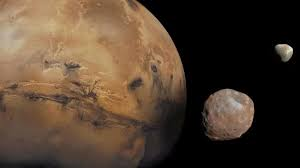Asteroid Destruction Hypothesis Explains Mars’ Unusual Moons
Why in the news?
A recent study suggests Mars’ moons, Phobos and Deimos, originated from a large asteroid torn apart by Mars’ gravity, solving the mystery of their unique orbits.
Introduction: Mars’ Peculiar Moons:
- Mars has two small, lumpy moons: Phobos (27 km) and Deimos (15 km).
- Their irregular shapes and asteroid-like features have led scientists to hypothesize they originated as asteroids.
- However, their circular and equatorial orbits conflict with the typical asteroid capture theory.
New Hypothesis: Asteroid Destruction:
- A new study proposes that a large asteroid was captured by Mars’ gravity millions of years ago.
- The asteroid approached Mars closely (as near as 5,150 km) and was torn apart by the planet’s gravity.
- Some fragments escaped, while others hit Mars, leaving craters. Remaining pieces collided, forming a debris cloud around Mars’ equator.
- Over time, gravitational influences from Mars and the Sun caused the debris to clump together, creating Phobos and Deimos.
- Supercomputer simulations support this hypothesis, explaining the moons’ unique orbits and structure.
Challenges to the Asteroid Capture Theory:
- Captured asteroids typically have tilted and elliptical orbits, unlike the neat orbits of Phobos and Deimos.
- Circular orbits suggest the moons were not merely captured but formed differently, possibly similar to Earth’s moon’s origin.
- Scientists theorize that debris from a collision or other significant event could have formed these moons, aligning their orbits with Mars’ equator.
Characteristics of Newly Discovered Moons:
- Uranus’ Moon (S/2023 U1):
- Diameter: ~5 miles (8 km).
- Among the smallest known moons in the solar system.
- Neptune’s Moons:
- S/2002 N5: Diameter ~14.3 miles (23 km).
- S/2021 N1: Diameter ~8.7 miles (14 km).
- Discovered using ground-based telescopes despite vast distances and small sizes.
About the Moons in the Solar System:
- Moons orbit planets, dwarf planets, and large asteroids, offering insights into celestial dynamics.
- Types of Moons:
- Regular Moons: Prograde orbits near equatorial planes.
- Irregular Moons: Inclined orbits, often captured.
- Moon Highlights by Body:
- Earth: 1 Moon (largest relative to planet).
- Mars: 2 Moons (Phobos, Deimos).
- Jupiter: 95 Moons (e.g., Galilean moons).
- Saturn: 146 Moons (Titan).
- Uranus: 28 Moons (Shakespearean names).
- Neptune: 16 Moons (Triton).
- Pluto: 5 Moons (Charon).
Sources Referred:
PIB, The Hindu, Indian Express, Hindustan Times




